For today's instalment of Lunch with an Architect, we head out for some Japanese with Antony Martin of MRTN Architects and chat about everything from keeping marriages intact to country music evangelism. Enjoy!
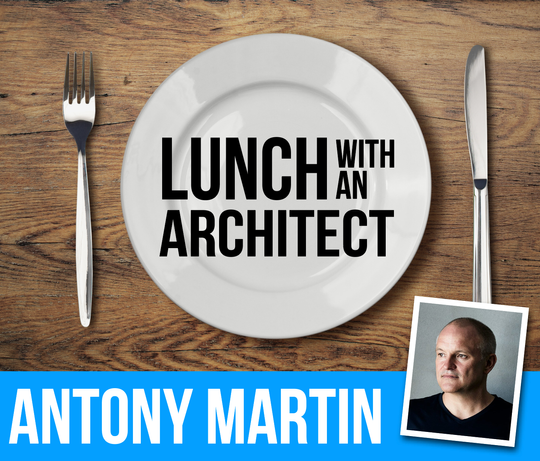
So although this is only a virtual lunch, Antony, if we were going out to lunch, where would we go? What is your favourite lunch choice?
I'm located in Brunswick, and I've got plenty of really good lunch choices. I think grilled fish would be the one thing I would be happy to eat forever; if I was stranded on a desert island, which is probably kind of well suited to being on an island. There's a restaurant here called Ima Asa Yoru, and they do a fish collar grilled with some rice and miso soup. I can't do that every day, but if I was going to treat myself, that would be it.
Can you tell me about what drew you to architecture?
The first time I began to consider becoming an architect was in year 6, it was my art teacher’s career advice to my mother. Going through secondary school, I was considering both architecture and engineering, but leaning more towards becoming an engineer because, while I've always enjoyed art and literature, I was also very into maths, science, physics, and chemistry. Then, through a good friend of mine, I started sailing with her father, who happened to be one of the leading architects in New Zealand. The boat was even called Brunelleschi! The entire crew was made up of architects. We used to go racing out on the bay, and when we were making our way back to the marina they would discuss things like the origins of reinforced concrete.
There was a University open day, and my mother took me along. We went to the engineering department and the architecture department. I realised then that I wouldn't have made a very good engineer and that architecture provided a better suited balance for me.
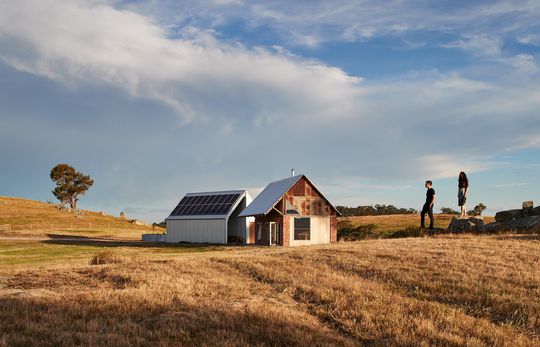
This off-grid country retreat fits in perfectly with its location.
Antony, do you have any mild superpowers when it comes to architecture?
I've been told by clients that I'm more accommodating than they assumed going into the process. There have been tense times during the process around costing or program or any number of things, yet after the project's completed, I've been pleasantly surprised to hear that we were more than willing to accommodate the changes they required or reducing things down to a square metre budget. It's about meeting their needs without being an egotistical architect.
There's definitely a perception in the industry that architects can be a bit egotistical, that it’s their way or the highway. But the reality is a good architect needs to be accommodating. That’s great feedback to get.
I believe you have a unique pre-design process that helps you and the client clarify what they actually need, what the possibilities for their site are, and how the required spaces might be arranged. Could you tell me a little about that process and why you decided to start working that way?
There are many reasons. A not insignificant one is that I can delay designing. I believe the longer we can delay active designing, the better the outcome. It's almost like a buffering stage beforehand. It allows us to gather all the information we need to start, and it shares knowledge with the client about why we're doing the things we do. Instead of post-rationalizing a design response, I like to provide a lot of information upfront about why we do the things that we do.
At the pre-design stage, I don't know what the design is, but these are the things we're going to consider before we get to design. Often there are harder conversations around budget and managing expectations, and I find it much easier to have those before people become passionate about a particular design we've produced. At that point, it becomes much more difficult to have those conversations. Instead, we can have more of a spreadsheet discussion rather than an emotive discussion.
80-90% of our clients haven't worked with an architect before. It's wonderful when we work with builders on their own houses, and I love working with people who have built or renovated their homes before. But most people don't have that experience, so we invest the time to work through a lot of background information with them so they develop a deeper understanding of what the opportunities, and the constraints, are in their project.
Yeah, right. It’s probably a quirk of the residential market that you only make one really big investment like that in your life and it’s probably the first time that many people are working with an architect.
I had a meeting with a potential new client over the weekend, and they said they had intentionally not done a project like what they were planning because they were keen on keeping their marriage intact for the past 30 years! They’re finally willing to take the risk now. But it’s a genuine concern people have about the process: Is it going to be stressful? How is it managed? And that's our job, to successfully guide that process, keep the stress levels down and marriages intact.
Should ‘keeping marriages intact’ become your company tagline?
Tell me, what’s your favourite thing about residential architecture? Is it keeping marriages intact?
There are things I've discussed, like how I love the process, but what I really like about residential architecture is the scale. The scale means that while there’s a lot of complexity, it’s still at a size where you can manage every aspect of it. With a large complex project, you need numerous teams involved, and no one person is aware of every aspect. That's not the case with a house. I also love the familiarity. We all live in a residential space. We all sleep in a bedroom, cook in a kitchen and wash up in a bathroom.. So working on people's homes is engaging because everybody knows what a house is and everybody has their own ideas about what makes a good home. No one's got a wrong idea about what a house is, right? There are so many nuances to it, that's what I like.

This modest addition in Rye transforms and reorients the home, respecting the original and ultimately creating a versatile and functional home.
Do you find that because everyone’s perception of what works well in a house varies, it causes any issues with misunderstandings?
It comes back to that mild superpower of being accommodating. You've got to be accommodating to what people want. That's an important part of our pre-design process. We have those conversations about the client's understanding of a home and our understanding. A classic example would be when we put the areas together from their brief, we schedule the areas before we do a floor plan. How many bedrooms and living areas? If we get a relationship where there’s one-third living spaces and two-thirds private spaces, we can have a conversation about why that's happening. Maybe they've got eight children, so it bumps up the private spaces. But ideally, it should be two-thirds public living spaces and one-third bedrooms.
This is totally changing tack (to use a sailing term), but to keep you on your toes, what's the first album you ever bought?
That’s a real right-hand turn, isn't it? Testing how elastic our thinking is, aren’t you? I think I bought a couple of albums when I was very young. The first one I remember was Pixies' "Doolittle." Another significant album purchase was in New York when I went into a record store and heard country music. I had never really liked country music before, but it was Merle Haggard's "Lonesome Fugitive," and I bought the album. Ever since then, I've been a country music tragic, even been to Nashville for New Year's Eve.
All from a random listen in New York!
I recommend everybody give country music a try. It's very good.
Pop this playlist on and have a listen to some of Antony's faves spanning country to alternative rock and dig into your Japanese luncheon
Back to architecture, what’s your favourite challenge in residential architecture?
I think my favourite challenge is when you get a client who is very engaged in the process and wants to learn about it. They come in clear about what they want, but then they start engaging with different ideas and continue being actively involved through the process. Those are our favourite projects. So, it’s not really about the type of project but about their process. We love doing houses, but we don't get to live in them at the end. We live in the process. So, if we've got a good client that's enjoying the process and is energised by it then I think that results in a better collaboration and in turn a better design.
What’s the residential project of yours that you're most proud of and why?
That's like choosing a favourite child, Brodie.
It is!
We are extremely proud of a country home in Tamworth we did, called House in the Dry. The clients were really engaged and passionate and very kind to us through the process. It was confronting to visit the site the first time; it was in the middle of a drought in Tamworth. The ground was like the surface of Mars. Through the design process, we focused on water capture and how to exist in an arid environment. We were able to create a house that not only do the clients love living in but also rehabilitated the entire site. It was a great instance of satisfying the client’s requirements and creating a house that interacted passively with the environment.
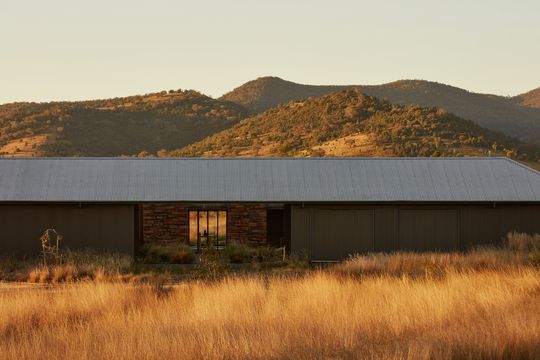
Antony's favourite child recent project, House in the Dry is a stunning example of contemporary homes that are suited to their rural (and sometimes hostile) environment.
If you were having your ultimate dinner party, who are the people from any time period that you'd most like to invite and why?
Here are four people that fascinate me, however, I don't think they would get on very well together, so it's better to have separate one-on-one dinners. First, definitely Patti Smith. I'm a massive Patti Smith fan. She’s an incredible musician and poet. Next, to cover my architect bases, Louis Khan or John Scott, a New Zealand architect. I've read a lot about Andy Warhol and I am fascinated about that period of time in New York City so I think he would be pretty entertaining to sit down with. Lastly, Winston Churchill. He’s a flawed character, but I find him so fascinating. He had an incredible life, from the Boer War to being Prime Minister. He was also an accomplished painter and even taught himself bricklaying.
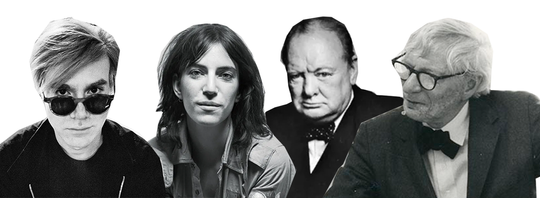
I didn't know he was a painter.
Yes, he spent a lot of time painting. He’s a very interesting character.
Do you have a favourite season?
It’s summer. I love the water, surfing, swimming, and being at the beach.
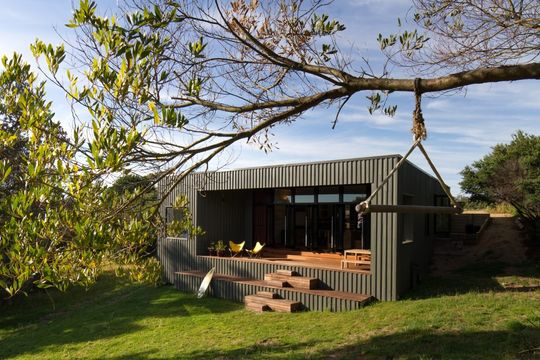
MRTN's Venus Bay Bach seems like the perfect place to while away long summer days to me.
Summer is my favourite too! What’s your preference between new homes and renovations, and why?
My preference is new homes. It’s great doing renovations and trying to work with an existing context, but there’s nothing like a new house where you need to consider and resolve everything in 360 degrees. That’s why we enjoy country projects because we often locate the site for the house. Those clients have a real connection to the land and are very passionate about doing the right thing.
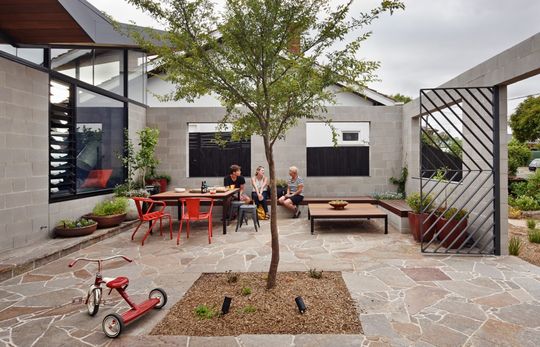
Fairfield Hacienda is a new home designed by MRTN Architects which cleverly deals with its orientation by creating a private, sunny courtyard at the front of the house!
What’s something about architects you wish more of the public knew?
I think it’s the wide-ranging experience and knowledge we bring to the process. Engineers know a lot about a little part, whereas architects know a little about many things.
Is there any life advice that you've received that's had an impact on you and your practice?
This relates to the last comment. When I was sailing and chatting with Marsh Cook and considering doing architecture, he told me to do technical drawing, physics, and art history. He advised me to look widely in my pursuit of knowledge, which was very useful advice. That led to a larger understanding of the context, which was really good advice.
Do you have a preference between Frank Lloyd Wright or Le Corbusier?
That’s a tricky one. I would have to say Corbusier. There’s something about his work that feels original and beyond what I could have done. Frank Lloyd Wright is fascinating for his planning of houses, but I’d choose Corbusier.
Is there any advice you would give to someone planning to build or renovate their house?
My advice is simple: get some advice early on. People think they need to have everything figured out before engaging an architect, but I think they’re missing out on a valuable part of what architects offer. Engage an architect early to consider budget, planning, and long-term needs. It’s a document you can sit on and act on when you’re ready.
That’s a great point. Architects can be very helpful in the pre-purchase stage, even before buying a house or piece of land.
We’ve done that in the past. For a project in Venus Bay, the clients engaged me to review sites before purchasing. It was a wonderful process and built trust. I strongly advised them on the site we ended up going with, and it turned out well.
Even for clients, explaining why they like a particular site can help clarify their thinking.
Yes, it’s like the advice that the best way to learn something is to teach it to someone else. Providing pros and cons helps their thinking.
Is there a book or resource you would recommend to people planning to build or renovate their home?
I don’t think a practical "how to build a house" book is right. I would suggest "In Praise of Shadows" by Jun'ichirō Tanizaki. It’s not directly about architecture but encourages thinking widely around the problem. Another suggestion is to visit Robin Boyd’s open homes to see real examples and expand your thinking about what a home can be.

Absolutely.
First-hand experiences are invaluable.
Some say there are two types of architect: one who reworks their thesis over and again and one who explores new ideas with every new project. Which is most like you and why?
You know the danger of this question, don’t you, Brodie? It’s like the tortoise and the hare. I would say I'm definitely the hare. We change from project to project, evolving and building on elements. It’s about the appropriateness of materiality, form, shape, and roof, which are very site and client dependent.
That plays into your mild superpower of being accommodating, changing the way you do things to suit the client and the site.
Yes, and I probably have a short attention span and need to change things up!